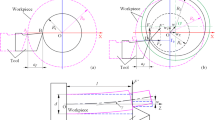Abstract
The turning of thin-walled, hollow, cylindrical parts is often not possible when using the common hydraulically operated 3- or 4-jaw chucks. This is due to the deformation of the part by the clamping force of the chuck. Even low clamping forces cause elastic deformations of the clamped workpiece, which results in surface errors due to machining after the unclamping and elastic recovery of the part. For this reason, several approaches have been adopted in the past in order to quantify and minimise the clamping-induced deformations. In this paper a model-based error compensation for thin-walled, cylindrical parts in turning is presented as a universal solution. In this work, a compensation by different models is designed and realised by an intelligent, adaptive and interchangeable turning tool holder with integrated sensors and actuators.












Similar content being viewed by others
References
Zeiher P (2002) Dünnwandige Teile deformationsarm spannen. Flexible Futter mit Spannköpfen fixieren Werkstücke mit hoher Rundlaufgenauigkeit. MM—Maschinenmarkt 36:68, 70–71
Seegräber L (1992) Standard- oder Sonderausführung? Spannbacken für die Präzisionsbearbeitung in Drehmaschinen. Schweizer Maschinenmarkt 92(25):46–48
Mayer B (1988) Werkstücke rasch und sicher spannen. Anwendungsbeispiele für Membranspannzeuge 121(2):143–145
Imhof H (1995) Vakuum macht’s möglich. Spannen dünnwandiger und nichtmagnetischer Werkstücke. Schweizer Maschinenmarkt 48:20–21
Witte H (1988) Vakuumspanntechnik besonders für neue Werkstoffe und dünnwandige Teile. In: Technische Keramik, Vulkan-Verlag, Essen, pp 85–87
Walter MF, Stahl JE (1995) Machining of ring shaped work pieces. J Mater Process Technol 48(1–4):239–245
Spur G, Abelein G, Stelzer C (1993) Force-controled clamping using three-jaw chucks. Production Engineering, München 1(1):111–116
Brinksmeier E, Heinzel C, Nowag L, Sölter J (2003) Simulation der Werkstückdeformation beim Spannen von Ringen. HTM—Härterei-Technische Mitteilungen 58(5):271–275
Malluck J-A, Melkote S-N (2004) Modeling of deformation of ring shaped workpieces due to chucking and cutting forces. Transactions of the ASME. J Manuf Sci Eng 126(10):141–147
Qiang L-Z (2000) Finite difference calculation of the deformations of multi-diameter workpieces during turning. J Mater Process Technol 98(3):310–316
Heisel U, Storchak M (2007) Simulation tool for modelling of interaction process by orthogonal cutting. Cutting Tool Technol Syst, Kharkov 73:335–341
Heisel U, Krivoruchko DV, Zaloha VA, Storchak M (2007) Cause analysis of errors in FE prediction of orthogonal performances, In: Proceedings of 10th CIRP international workshop on modeling of machining operations, Calabria, S. 141–148
Acknowledgments
The financial support by the Baden-Württemberg Stiftung is gratefully acknowledged.
Author information
Authors and Affiliations
Corresponding author
Rights and permissions
About this article
Cite this article
Heisel, U., Kang, C. Model-based form error compensation in the turning of thin-walled cylindrical parts. Prod. Eng. Res. Devel. 5, 151–158 (2011). https://doi.org/10.1007/s11740-010-0288-4
Received:
Accepted:
Published:
Issue Date:
DOI: https://doi.org/10.1007/s11740-010-0288-4




